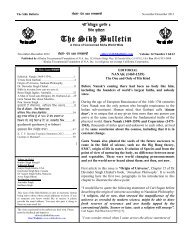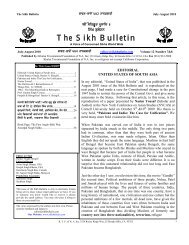Create successful ePaper yourself
Turn your PDF publications into a flip-book with our unique Google optimized e-Paper software.
<strong>The</strong> <strong>Sikh</strong> <strong>Bulletin</strong> jyT-hwV 542 nwnkSwhI May-June 2010<br />
In another verse (GGS Page 927 Ramkali) Guru Arjun<br />
makes the principle crystal clear:<br />
Rutee Maah Moorat Gharaee<br />
Gun Uchrat Sobhaavant Jee-o.<br />
Blessed <strong>and</strong> auspicious is that season, that month, that<br />
moment, that hour, when you chant the Lord’s Glorious<br />
Praises.<br />
<strong>The</strong> principle is clear. Days (or hours) are not<br />
auspicious or otherwise simply because they are named<br />
such or happen to be such or because they coincide with<br />
the positions of the sun, moon or other celestial bodies.<br />
<strong>The</strong> beginning of the month is no more or less<br />
auspicious than the second, third or 30 th day. What<br />
makes the moment auspicious is what the <strong>Sikh</strong> does<br />
spiritually during that moment.<br />
It follows therefore that sangr<strong>and</strong>, massia, puranmashi<br />
or Monday or Wednesday, or the 1 st or the 31 st has no<br />
meaning, significance or relevance to a <strong>Sikh</strong> simply on<br />
its own.<br />
(b) Linking Banees with occasions. <strong>Sikh</strong>s need to<br />
appreciate that no Banee in the entire Guru Granth<br />
Sahib is tied to any particular event, occasion <strong>and</strong><br />
celebration. This does not however mean that <strong>Sikh</strong>s<br />
have not (wrongly) tied Banees to occasions. Ramkali<br />
Sadd (GGS page 923) has been tied by some <strong>Sikh</strong>s to<br />
be read during the death ceremony. Some gurdwara<br />
parbh<strong>and</strong>aks <strong>and</strong> granthis recite it, arguing that this<br />
banee evokes sad emotions – hence meant for sad<br />
occasions. Reciting Ramkali Sadd has thus become a<br />
ritual related to death in some gurdwaras. Never mind<br />
that this banee is a critique of ritual <strong>and</strong> a clear call for<br />
a <strong>Sikh</strong> to rise above the sway of emotions. <strong>The</strong> Gurmat<br />
practice of reading the one <strong>and</strong> same An<strong>and</strong> Sahib<br />
during all <strong>Sikh</strong> functions, irrespective of nature (death,<br />
birth, joy or otherwise), <strong>and</strong> the reciting of the same<br />
Salok Mahala 9 during every Bhog ceremony (death /<br />
birth/joyous/otherwise) is indication of this Gurmat<br />
principle. <strong>The</strong> <strong>Sikh</strong> Rehat Maryada of An<strong>and</strong> Karaj<br />
does require the singing of Lavan, but Lavan is not a<br />
Banee (as Barah Maha, Ramkali Sadd, Sukhmani or<br />
Japji is for instance). <strong>The</strong> Lavan consists of one single<br />
shabad with four parts (Suhee Fourth Guru, GGS pg<br />
773). This shabad is not even titled as Lavan by the<br />
Guru. We have given it the title of Lavan (meaning<br />
circumambulation). Nothing should stop any <strong>Sikh</strong> from<br />
reading/singing this shabad at any occasion. On one<br />
occasion, I have witnessed this Lavan shabad turning<br />
out as the Hukumnama after the Ardas during a death<br />
ceremony. What better way for the Guru to instill the<br />
notion that the Lavan shabad is not reserved for An<strong>and</strong><br />
Karaj.<br />
Linking Barah Maha to sangr<strong>and</strong> is therefore not in<br />
accordance with Gurmat. It is an afterthought.<br />
<strong>Sangr<strong>and</strong></strong> (<strong>and</strong> a host of other vedic/bhramanical<br />
practices/occasions/events) has obviously been<br />
brought in as <strong>Sikh</strong> practice first <strong>and</strong> the effort to<br />
legitimize, justify, <strong>and</strong> obfuscate was undertaken much<br />
later.<br />
It is fairly obvious that sangr<strong>and</strong> was smuggled into<br />
<strong>Sikh</strong> gurdwaras by certain elements (mahants,<br />
derawads <strong>and</strong> other deviants) whose only justification<br />
was that they owned / ran our gurdwaras <strong>and</strong> had<br />
possession of our parchar for over two centuries after<br />
the demise of the tenth Guru. <strong>The</strong> dem<strong>and</strong> for<br />
justification came very much later, when thinking<br />
<strong>Sikh</strong>s started asking for it. <strong>The</strong> justifications were<br />
therefore cooked up by the beneficiary elements<br />
(modern day sants, dera fellows, gurmat- illiterate<br />
parbh<strong>and</strong>aks etc) who could not reach any higher than<br />
the st<strong>and</strong>ards of hey diddle diddle. <strong>The</strong>y had no<br />
knowledge of Guru Nanak’s Barah Maha, they had<br />
never read (let alone understood) either of the Barah<br />
Maha, had no interest in looking beyond the title of<br />
these two banees, could not be concerned with<br />
thinking through the logic of two Barah Mahas, or<br />
that the banee was a critique of everything that<br />
sangr<strong>and</strong> stood for, <strong>and</strong> had no knowledge whatsoever<br />
of the true principles of Gurmat.<br />
All these sangr<strong>and</strong>ees could do was to cook up sakhis<br />
of <strong>Sikh</strong>s going to Gurus, <strong>and</strong> the Gurus instructing the<br />
<strong>Sikh</strong>s to celebrate this occasion <strong>and</strong> whatever else that<br />
these sants, mahants <strong>and</strong> deviants had smuggled into<br />
our gurdwaras. <strong>The</strong>ir sakhis are essentially “do as you<br />
are told, because the Guru told the <strong>Sikh</strong>s.” Knowing<br />
very well, perhaps, that <strong>Sikh</strong>s rarely make an effort to<br />
underst<strong>and</strong> their treasure of gurbanee, these<br />
adulterators ventured to link some banee or other to<br />
their smuggled practices; never mind if the banee<br />
actually condemned that very practice. <strong>The</strong>y linked<br />
Gagan Mei Thal Rav Ch<strong>and</strong> Deepak Baney (Dhnasri<br />
Guru Nanak: GGS page 66) to their smuggled practice<br />
of Aarti in the gurdwaras. And they linked a banee<br />
K. T. F. of N. A. Inc. 3524 Rocky Ridge Way, El Dorado Hills, CA. 95762 6
















